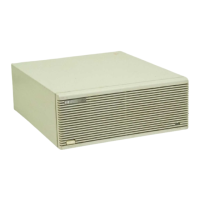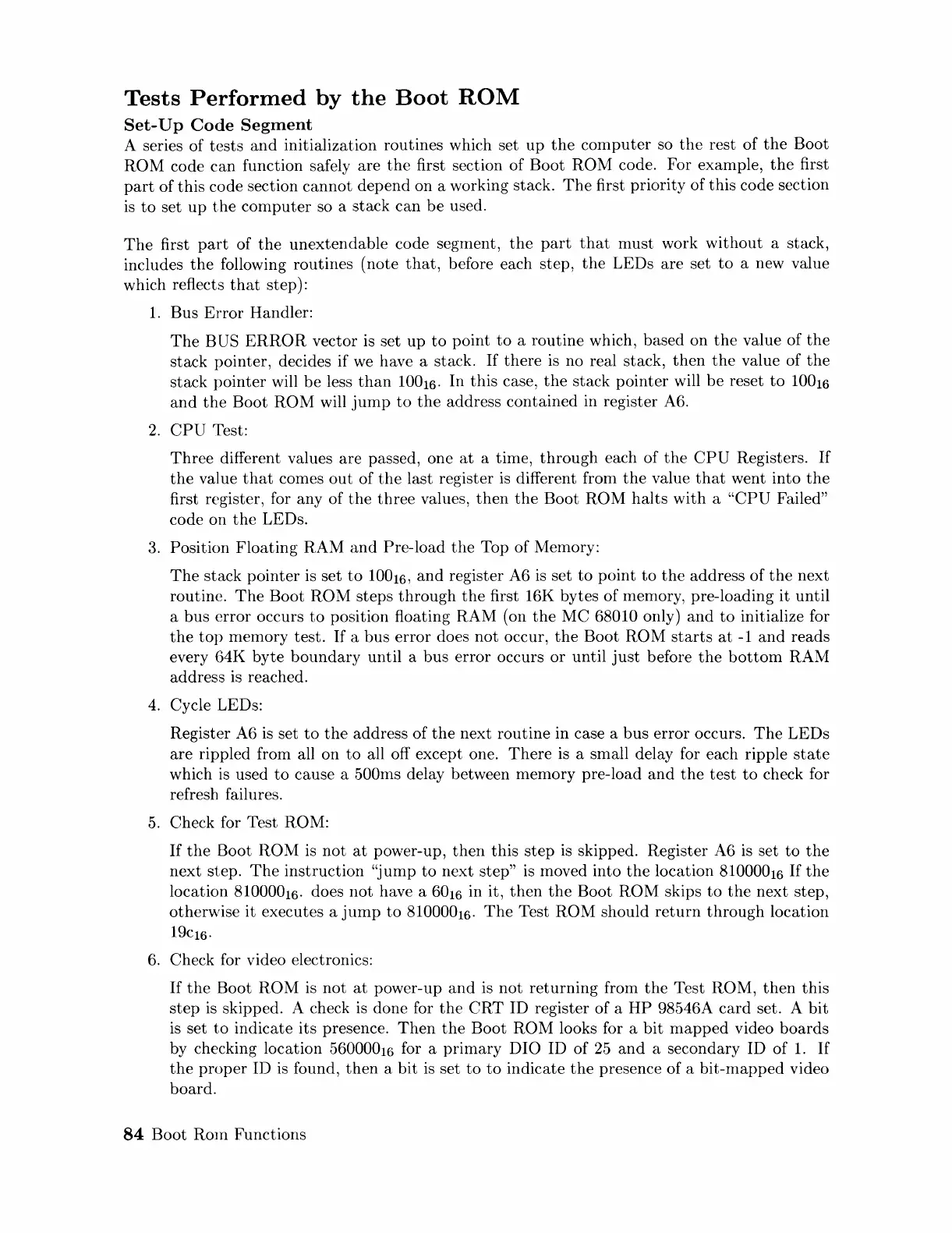Tests
Performed
by
the
Boot
ROM
Set-
U p
Code
Segment
A series of
tests
and
initialization routines which set
up
the
computer
so
the
rest
of
the
Boot
ROM code
can
function safely are
the
first section
of
Boot
ROM
code. For exanlple,
the
first
part
of
this
code section
cannot
depend on a working stack.
The
first priority of
this
code section
is
to
set
up
the
computer
so a stack
can
be
used.
The
first
part
of
the
unextendable
code segment,
the
part
that
must
work
without
a stack,
includes
the
following routines (note
that,
before each step,
the
LEDs are set
to
a new value
which reflects
that
step):
1.
Bus
Error
Handler:
The
BUS
ERROR
vector is set
up
to
point
to
a routine which, based on
the
value of
the
stack pointer, decides if
we
have a stack.
If
there
is
no real stack,
then
the
value
of
the
stack
pointer
will
be
less
than
10016.
In
this
case,
the
stack
pointer
will
be
reset
to
10016
and
the
Boot
ROM
will
jump
to
the
address contained in register A6.
2.
CPU
Test:
Three
different values are passed, one
at
a time,
through
each of
the
CPU
Registers.
If
the
value
that
comes
out
of
the
last register
is
different from
the
value
that
went into
the
first register, for any of
the
three
values,
then
the
Boot
ROM
halts
with
a
"CPU
Failed"
code on
the
LEDs.
3.
Position
Floating
RAM
and
Pre-load
the
Top of Memory:
The
stack
pointer
is set
to
10016,
and
register A6
is
set
to
point
to
the
address
of
the
next
routine.
The
Boot
ROM
steps
through
the
first 16K bytes
of
memory, pre-loading
it
until
a bus
error
occurs
to
position floating RAM (on
the
MC
68010 only)
and
to
initialize for
the
top
rrlemory
test.
If
a bus
error
does
not
occur,
the
Boot
ROM
starts
at
-1
and
reads
every
64K
byte
boundary
until a bus
error
occurs
or
until
just
before
the
bottom
RAM
address is reached.
4.
Cycle LEDs:
Register A6
is
set
to
the
address
of
the
next
routine
in case a
bus
error
occurs.
The
LEDs
are
rippled from all on
to
all off except one.
There
is a small delay for each ripple
state
which is used
to
cause a 500ms delay between memory pre-load
and
the
test
to
check for
refresh failures.
5.
Check for Test ROM:
If
the
Boot
ROM
is
not
at
power-up,
then
this
step
is
skipped. Register A6 is set
to
the
next
step.
The
instruction "jump
to
next
step" is moved into
the
location 81000016
If
the
location 81000016. does
not
have a
6016
in it,
then
the
Boot
ROM
skips
to
the
next
step,
otherwise
it
executes a
jump
to
81000016.
The
Test ROM should
return
through
location
19c16·
6.
Check for video electronics:
If
the
Boot
ROM
is
not
at
power-up
and
is
not
returning
from
the
Test ROM,
then
this
step
is
skipped. A check
is
done for
the
CRT
ID register of a
HP
98546A
card
set. A
bit
is
set
to
indicate
its
presence.
Then
the
Boot
ROM
looks for a
bit
mapped
video boards
by checking location
56000016 for a
primary
DIO ID
of
25
and
a secondary ID
of
1.
If
the
proper
ID
is
found,
then
a
bit
is
set
to
to
indicate
the
presence of a
bit-mapped
video
board.
84
Boot
ROln
Functions
Artisan Technology Group - Quality Instrumentation ... Guaranteed | (888) 88-SOURCE | www.artisantg.com

